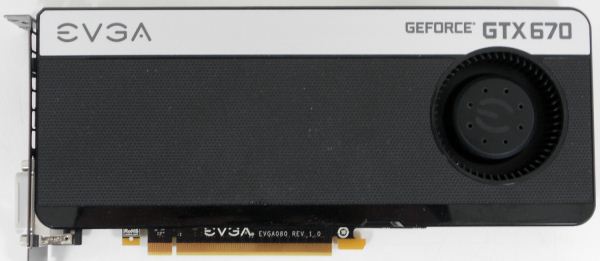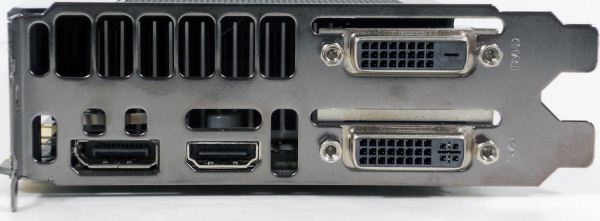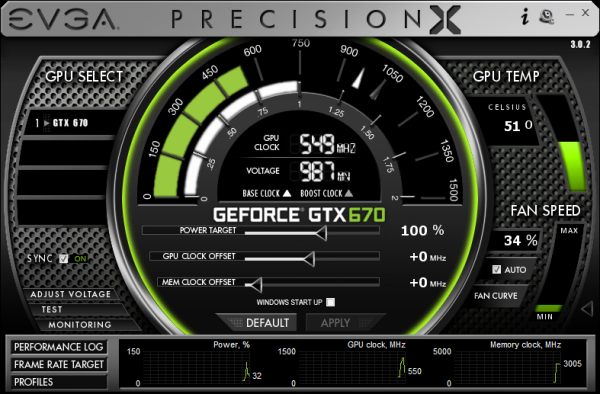NVIDIA GeForce GTX 670 Review Feat. EVGA: Bringing GK104 Down To $400
by Ryan Smith on May 10, 2012 9:00 AM ESTMeet The EVGA GeForce GTX 670 Superclocked
Our second card of the day is EVGA’s GeForce GTX 670 Superclocked, which in EVGA’s hierarchy is their first tier of factory overclocked cards. EVGA is binning GTX 670s and in turn promoting some of them to this tier, which means the GTX 670 Superclocked are equipped with generally better performing chips than the average reference card.
| GeForce GTX 670 Partner Card Specification Comparison | ||||
| EVGA GeForce GTX 670 Superclocked | GeForce GTX 670 (Ref) | |||
| CUDA Cores | 1344 | 1344 | ||
| Texture Units | 112 | 112 | ||
| ROPs | 32 | 32 | ||
| Base Clock | 967MHz | 915MHz | ||
| Boost Clock | 1046MHz | 980MHz | ||
| Memory Clock | 6210MHz | 6008MHz | ||
| Memory Bus Width | 256-bit | 256-bit | ||
| Frame Buffer | 2GB | 2GB | ||
| TDP | 170W | 170W | ||
| Manufacturing Process | TSMC 28nm | TSMC 28nm | ||
| Width | Double Slot | Double Slot | ||
| Length | 9.5" | 9.5" | ||
| Warranty | 3 Years | N/A | ||
| Price Point | $419 | $399 | ||
For the GTX 670 SC, EVGA has given both the core clock and memory clock a moderate boost. The core clock has been increased by 52MHz (6%) to 967MHz base and 66MHz (7%) boost to 1046MHz. Meanwhile the memory clock has been increased by 202MHz (3%) to 6210MHz.
Other than the clockspeed changes, the GTX 670 SC is an almost-reference card utilizing a reference PCB with a slightly modified cooler. EVGA is fabricating their own shroud, but they’ve copied NVIDIA’s reference shroud down to almost the last detail. The only functional difference is that the diameter of the fan intake is about 5mm less, otherwise the only difference is that EVGA has detailed it differently than NVIDIA and used some rounded corners in place of square corners.
The only other change you’ll notice is that EVGA is using their own high flow bracket in place of NVIDIA’s bracket. The high flow bracket cuts away as much metal as possible, maximizing the area of the vents. Though based on our power and temperature readings, this doesn’t seem to have notably impacted the GTX 670 SC.
While we’re on the matter of customized cards and factory overclocks, it’s worth reiterating NVIDIA’s position on factory overclocked cards. Reference and semi-custom cards (that is, cards using the reference PCB) must adhere to NVIDIA’s power target limits. For GTX 670 this is a 141W power target, with a maximum power target of 122% (170W). Fully custom cards with better power delivery circuitry can go higher, but not semi-custom cards. As a result the flexibility in building semi-custom cards comes down to binning. EVGA can bin better chips and use them in cards such as the Superclocked – such as our sample which can go 17 boost bins over the base clock versus 13 bins for our reference GTX 670 – but at the end of the day for stock performance they’re at the mercy of what can be accomplished within 141W/170W.
In any case, as the card is otherwise a reference GTX 670 EVGA is relying on the combination of their factory overclock, their toolset, and their strong reputation for support to carry the card. EVGA has priced the card at $419, $20 over the GTX 670 MSRP, in-line with other factory overclocked cards.
On the subject of pricing and warranties, since this is the first EVGA card we’ve reviewed since April 1st, this is a good time to go over the recent warranty changes EVGA has made.
Starting April 1st, EVGA has implemented what they’re calling their new Global Warranty Policy. Starting July 1st, 2011 (the policy is being backdated), all new EVGA cards ship with at least a 3 year warranty. And for the GTX 600 series specifically, so far EVGA has only offered models with a 3 year warranty in North America, which simplifies their product lineup.
To complement the 3 year warranty and replace the lack of longer term warranties, EVGA is now directly selling 2 and 7 year warranty extensions, for a total of 5 and 10 years respectively. So instead of buying a card with a 3 year warranty or a longer warranty, you’ll simply buy the 3 year card and then buy a warranty extension to go with it. However the extended warranty requires that the card be registered and the warranty purchased within 30 days.
The second change is that the base 3 year warranty no longer requires product registration. EVGA has other ways to entice buyers into registering, but they’ll now honor all applicable cards for 3 years regardless of the registration status. At the same time the base 3 year warranty is now a per-product warranty (e.g. a transferable warranty) rather than per-user warranty, so the base warranty will transfer to 2nd hand buyers. The extended warranties however will not.
The third change is how EVGA is actually going to handle the warranty process. First and foremost, EVGA is now allowing cards to be sent to the nearest EVGA RMA office rather than the office for the region the card was purchased from. For example a buyer moving from Europe to North America can send the card to EVGA’s North American offices rather than sending it overseas.
Finally, EVGA is now doing free cross shipping, alongside their existing Advanced RMA program. EVGA will now cross-ship replacement cards for free to buyers. The buyer meanwhile is responsible for paying to ship the faulty card back and putting up collateral on the new card until EVGA receives the old card.
There’s also one quick change to the step-up program that will impact some customers. With the move to purchasing extended warranties, the step-up program is only available to customers who either purchase an extended warranty or purchase an older generation card that comes with a lifetime warranty. Step-up is not available to cards with only the base 3 year warranty.
Moving on, along with EVGA’s new warranty EVGA is bundling the latest version of their GPU utilities, Precision X and OC Scanner X.
Precision X, as we touched upon quickly in our GTX 680 review, is the latest iteration of EVGA’s Precision overclocking & monitoring utility. It’s still based on RivaTuner and along with adding support for the GTX 600 series features (power targets, framerate caps, etc), it also introduces a new UI. Functionality wise it’s still at the top of the pack along with the similarly RivaTuner powered MSI Afterburner. Personally I’m not a fan of the new UI – circular UIs and sliders aren’t particularly easy to read – but it gets the job done.
OC Scanner X has also received a facelift and functionality upgrade of its own. Along with its basic FurMark-ish stress testing and error checking, it now also offers a basic CPU stress test and GPU benchmark.



















414 Comments
View All Comments
Gastec - Tuesday, November 13, 2012 - link
Your every comment is an attack at ATi/AMD video cards or people who seem to be using them( maybe). Why?You get payed to do negative publicity for AMD on the review sites? Because having a Ati card die on you in the middle of some important event in you gaming life( like raiding in WoW , am I close or am I close ;-) could not be the only reason.
shin0bi272 - Friday, May 11, 2012 - link
I think the reason for the missing memory chips is because they will be releasing the 685 in aug or sep which is supposed to be 4gb and run on a 512bit bus. It could be possible to increase the size of the gpu core and double the amount of ram and stil have it on a card this length.30% faster than the 670 (685 is supposed to be 25% faster than the 680 and the 670 is 5% slower than the 680) on the same size card but using 2x8 pin connectors instead of 2x6pin. Now imagine an after market or water cooler on it... yeah.
You'll get great FPS on all those brand new console ports.
KivBlue - Friday, May 11, 2012 - link
$400 for a graphics card is just too much.medi01 - Saturday, May 12, 2012 - link
For me too. In 200$-ish range it looks like AMD 7850 / 7870 are the only reasonable options.PS
Honestly I don't get all the hype about 680/670. Cards are only marginally better than AMDs offering (losing in some games, winning in some games).
Power consumption difference according to techpowerup is only 2 watt in idle, about 9 watt at full load. Not a big deal either.
Basically a slight price drop by AMD on 7950/7970 (for whoever really wants those) once these cards actually become available and that's it.
I also wonder, how many "enthusiasts" with multi-monitor setups in the need of a faster card are out there.
PPS
Worst part of it would be nVidia releasing confusing mix of completely different cards lower end cards released under the same name, to confuse consumer.
CeriseCogburn - Saturday, May 12, 2012 - link
I guess considering you think $200 equals $335 and that also equals $250, we can say your comment equals a big fat lie, and when a big fat lie is what one immediately starts off with, everyone knows something is WRONG.Gastec - Tuesday, November 13, 2012 - link
Again you attack someone who posted a comment about AMD cards, just because. You are obviously a troll and someone from this, STILL RESPECTED computer magazine should ban you.Gastec - Tuesday, November 13, 2012 - link
Yes but people who buy these have enough money to buy even the $3000-4000. Tesla K20 ones . Many of them have money from their parents, if you catch my drift.RegEDDIT - Sunday, May 13, 2012 - link
I managed to buy one from Amazon before they went out of stock, and I must say, I am pleased. BF3 plays like a champ, Skyrim is smooth as butter, and Adobe Premiere edits like a champ now with Nvidia hardware acceleration. This is on a 1920x1080 monitor with an old q6700 quad core @ 2.666 GHz and 800Mhz RAM. I do not expect to buy another card for a long while.CeriseCogburn - Sunday, May 13, 2012 - link
Here's COMPUTE SOFTWARE BASE in action." Adobe Premiere edits like a champ now with Nvidia hardware acceleration "
Nvidia wins. amd loses in compute.
Zebo - Sunday, May 13, 2012 - link
7950 has 40-50% OC potential being servilely down tuned @ 800Mhz.If AMD is smart they will release a 1100Mhz version and wreck 670s party.
If you're an overclocked you'd be dumb to buy 670 with its limited control and potential of 7950. Let alone of you're on water.